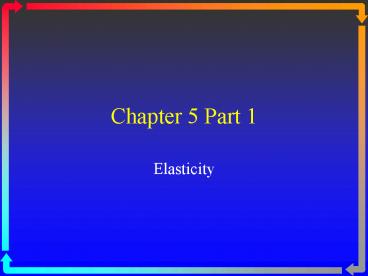Chapter 5 Part 1 - PowerPoint PPT Presentation
1 / 27
Title:
Chapter 5 Part 1
Description:
Chapter 5 Part 1 Elasticity Elasticity of Demand Elasticity a measure of the responsiveness of Qd or Qs to changes in market conditions Price Elasticity of Demand ... – PowerPoint PPT presentation
Number of Views:51
Avg rating:3.0/5.0
Title: Chapter 5 Part 1
1
Chapter 5 Part 1
- Elasticity
2
Elasticity of Demand
- Elasticity a measure of the responsiveness of
Qd or Qs to changes in market conditions - Price Elasticity of Demand measure of how much
the Qd responds to a change in the P - Computed as change in Qd
- change in P
3
Elastic v. Inelastic Demand
- D for a good is elastic if the Qd responds
substantially to a change in P - Examples McDonalds hamburgers
- D for a good is inelastic if the Qd responds only
slightly to a change in P - Examples Insulin
4
Determinants of Price Elasticity of D
- Availability of Close Substitutes - goods w/
close substitutes tend to be more elastic goods
w/o close substitutes tend to be more inelastic
Ex butter - Necessities vs. Luxuries necessities tend to
have inelastic demands luxuries tend to have
elastic demands Ex gas vs. sailboat
5
Contd
- Definition of the Market broad categories have
fairly inelastic demands, narrowly defined
markets usually are more elastic Ex food vs.
Green apple - Time Horizon goods tend to have more elastic
demands over long time periods. Ex P of gas
rises, Qd barely falls for a while, but in the
long run D falls substantially
6
Rank the following items from most to least
elastic
- Beef
- Salt
- European vacation
- Steak
- Honda Accord
- Dijon Mustard
7
Results?
- European Vacation
- Honda Accord
- Steak
- Dijon Mustard
- Beef
- salt
8
Computing the Price Elasticity of Demand
- The price elasticity of demand is computed as the
percentage change in the quantity demanded
divided by the percentage change in price.
9
Computing the Price Elasticity of Demand
- Example If the price of an ice cream cone
increases from 2.00 to 2.20 and the amount you
buy falls from 10 to 8 cones, then your
elasticity of demand would be calculated as
10
- Along a D curve, P and Q move in opposite
directions, which would make price elasticity
negative. - We will drop the minus sign and report all price
elasticities as positive numbers (or just take
the absolute value)
11
The Midpoint Method A Better Way to Calculate
Percentage Changes and Elasticities
- The midpoint formula is preferable when
calculating the price elasticity of demand
because it gives the same answer regardless of
the direction of the price change. - The midpoint is the number halfway between the
start end values, the average of those values.
12
MIDPOINT FORMULA
13
The Midpoint Method A Better Way to Calculate
Percentage Changes and Elasticities
- Example If the price of an ice cream cone
increases from 2.00 to 2.20 and the amount you
buy falls from 10 to 8 cones, then your
elasticity of demand, using the midpoint formula,
would be calculated as
14
Types of Elasticities
- When the price elasticity of demand is gt1, demand
is elastic - When the price elasticity of demand is lt1, the
demand is inelastic. - When the price elasticity of demand is 1, the
demand has unit elasticity.
15
Another way to think about it
- If the ?Qd() gt ?P() then its ELASTIC
- If the ?Qd() lt ?P() then its INELASTIC
16
The Variety of Demand Curves
- Perfectly Inelastic
- Quantity demanded does not respond to price
changes. - Perfectly Elastic
- Quantity demanded changes infinitely with any
change in price. - Unit Elastic
- Quantity demanded changes by the same percentage
as the price.
17
- Because the price elasticity of demand measures
how much quantity demanded responds to the price,
it is closely related to the slope of the demand
curve. - But it is not the same thing as the slope!
18
Perfectly Inelastic Demand
(a) Perfectly Inelastic Demand Elasticity Equals
0
Price
Quantity
0
19
Inelastic Demand
(b) Inelastic Demand Elasticity Is Less Than 1
Price
Quantity
0
20
Unit Elastic Demand
(c) Unit Elastic Demand Elasticity Equals 1
Price
Quantity
0
21
Elastic Demand
(d) Elastic Demand Elasticity Is Greater Than 1
Price
Quantity
0
22
Perfectly Elastic Demand
(e) Perfectly Elastic Demand Elasticity Equals
Infinity
Price
Quantity
0
23
Total Revenue and Price Elasticity of Demand
- Total revenue is the amount paid by buyers and
received by sellers of a good. - Computed as the price of the good times the
quantity sold. - TR P x Q
- TR is also called Total Expenditure or TE!!
24
Total Revenue
Price
When the price is 4, consumers will demand 100
units, and spend 400 on this good.
Quantity
0
25
TR TEST
- If D is inelastic P rises, Qd falls gt TR rises
- P falls, Qd rises gt TR falls
- If D is elastic P rises, Qd falls gt TR falls
- P falls, Qd rises gt TR rises
- If D is unit elastic P rises, Qd falls gt TR
- P falls, Qd rises gt TR
26
How Total Revenue Changes When Price Changes
Inelastic Demand
Price
Price
An Increase in price from 1 to 3
leads to an Increase in total revenue from 100
to 240
Quantity
0
Quantity
0
27
How Total Revenue Changes When Price Changes
Elastic Demand
Price
Price
An Increase in price from 4 to 5
leads to an decrease in total revenue from 200
to 100
Quantity
Quantity
0
0
Note that with each price increase, the Law of
Demand still holds an increase in price leads
to a decrease in the quantity demanded. It is
the change in TR that varies!































